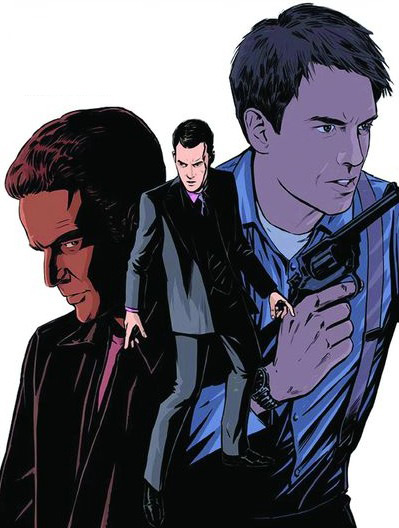Welcome to Wednesday Comics Pull-List, here on Tor.com! Every week we post reviews of a select handful of this week’s comic releases. From those reviews, we let you know what we would pull for keeps.
This week’s batch includes:
- 1 Month 2 Live #5
- Bullet To The Head #4
- Captain America: Patriot #2
- Detective Comics #869
- Driver For The Dead #2
- Franken-Castle #21
- Terminator: 1984 #1
- Torchwood #3
- Wetworks: Mutations
- X-Men vs. Vampires #1
This week’s strongest issues dealt with Captain America as a living symbol and what happens when even the country’s brightest symbol can’t overcome its deepest flaws, gleeful romps through those that work for the dead and those who are about to become it, and one title that brings one of our reviewers to tears.
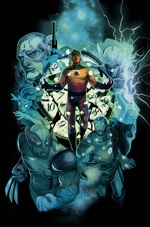 1 Month 2 Live #5 (of 5)
1 Month 2 Live #5 (of 5)
Written by Rick Remender
Art by Jamie McKelvie
(Marvel Comics)
Pull: Yes. Get the whole series. Can I give this comic a standing ovation? Because I’d like to give it that.
Chris says: I could not avoid tearing up while reading this issue.
I reviewed this weekly mini-series when it debuted earlier this month and saw a lot of promise in it. The concept was about a simple man named Dennis Sykes who gains both superpowers and aggressive cancer in one fell swoop. (Hence the title of the series.) Having limped through life as middle management at a bank, enforcing the heartless decisions of others, he now wants to spend his remaining time making a difference, if only so his step-daughter Kelly will respect him. In this final issue, his galaxy-saving done, Dennis focuses on what he’s realized is the real difference he can make in the world. As his cancer advances through its final stages, he needs to teach Kelly how to be a better person than he managed to be.
Like a lot of awkward young things out there, comic books and superheroes shepherded me through my youth and into adulthood that resonates far too well with the common details of Dennis’s life. I would have enjoyed reading a deconstruction of the superhero on these details alone, but marrying Dennis’s story with the effects of a family dealing with cancer made this comic very, very personal. Writer Rick Remender and artist Jamie McKelvie tell this story masterfully and, most importantly, respectfully.
I see myself in Dennis, the man who’s honorable ideals became subsumed under the malaise of finding a job, supporting a family, just making it to next month… I see myself in hi step-daughter Kelly, watching a parent suffer slowly through cancer… I see myself in Dennis’s wife Abbey, watching her loved one die and fumbling for a way to deal with it. A way that just doesn’t exist. Remender captures perfectly the stark unfairness of losing someone to cancer. How there’s no way to not feel it, to not watch your loved one dissipate before you, because ignoring that suffering is even worse.
We are taken through Dennis’s final stages in this issue, and while his cancer isn’t glamorized the details are still real nonetheless. Dennis can take a stroll with Kelly, but not for long, and he can’t finish his ice cream or he’ll throw up again. In his fight with Hammerhead he isn’t hit, but he can’t keep himself on his feet. And when he finally passes, artist Jamie McKelvie shows Abbey wordlessly choking back an anger that she knows is now useless, but which she can’t help feeling.
The aspects of Dennis’s story—not only his disease but his actions and the family around him—all ring true, and this makes this story all the more powerful. If I have any criticism regarding this comic, it’s that having established Marvel heroes show up tends to throw one out of that story, which is a shame, because here they pale against Dennis.
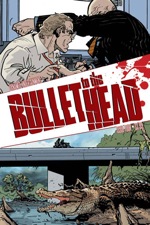 Bullet to the Head #4
Bullet to the Head #4
Written by Matz
Art by Colin Wilson
(Dynamite Entertainment)
Pull: I wouldn’t but then again, if you’ve read the first three and really dug them, who am I to rain on your parade?
Annie says: I like to think I’m capable of picking up a series in the middle, or at least the early parts, and piecing together what’s going on and who is whom, but with this comic I just couldn’t absorb any of the information beyond the absolute bare bones. What initially made me want to start reading this comic was the artwork, which I’ll have to expand on later but in the interim, I’d like to discuss why more is sometimes too much and less is, in my opinion, always more.
There is a lot of dialogue in this comic, a lot of conflicting characters and a lot of perpendicular storylines. I’m willing to eat my words here but, in my opinion, there is just too much going on in this issue. Too many people being introduced all at the same time, too many characters joining up together without any clear symmetry and, for a noir comic, not enough detail pertaining to the drama the artwork lends to the story. There are 32 pages in this issue, seven of those are advertisements, the rest is more panels stuffed into pages than I’ve seen in a long time. To each their own for sure, but from what I understand of the story, it’s a good one. Two assassins and two detectives have stories that run along the same timeline and eventually collide bringing forces of “good” and “evil” together on the same team. This comic follows the standard formula for a noir comic, successfully.
The artwork, though, was capable of telling the story by itself. I could have done with a lot less words while keeping the same amount of panels per page. I love a story where New York is depicted in an honest way. There’s a scene, specifically, where a man and woman are jogging through Central Park when they get into a conflict with a hitman in one of the tunnels. There’s a close up of a man’s dead body in the tunnel, you’re clearly being shown the less than light side of New York in this frame, only to be shown an aerial view of the same location, in all of its splendor and innocence, in the next. There is a constant battle between good and evil in this comic that’s done through words and images that encapsulates all of the things people love and hate about living here.
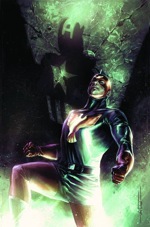 Captain America: Patriot #2 (of 4)
Captain America: Patriot #2 (of 4)
Written by Karl Kesel
Art by Mitch Breitweiser
(Marvel Comics)
Pull: Yes—especially if you’ve already picked up issue #1. If you haven’t, then either find ‘em both, or start looking forward to the trade!
Matt says: The Captain America: Patriot miniseries drops its second issue this week—a mere two weeks after issue #1. As I had hoped, the relative moral clarity of the first issue’s World War II setting has given way to a more morally grey postwar period; this issue marks the escalating paranoia of the Cold War (along with the personal difficulties that come along with having to face one’s former war allies as enemies), along with a well-handled foray into the straitjacket of postwar conservative American social mores.
At the heart of this issue is Karl Kesel’s exploration of what it means to take on a symbolic role—a theme we saw introduced in issue #1, and greatly expanded upon here. In this issue, Jeff Mace learns that his old friend and photographer Jack Casey has committed suicide. It’s not only that, upon returning from the war, Casey was unable to find work; worse still, he was “blue ticketed” out of the military. The Blue Ticket, for those who don’t know their history, is a discharge without honor (albeit not a “dishonorable discharge”), used mostly to flush blacks and homosexuals out of the military—blue discharges were (illegally) denied GI Bill benefits, and faced considerable discrimination upon returning to their civilian lives.
Mace—the Patriot and now the symbol of all America as its “Captain”—sees wrong being done, and wants to attend Casey’s funeral as Captain America. The rest of the “All Winners” squad, however, talk him out of it. “Trust us, Jeff,” says the Human Torch, “if you go as Captain America, you’ll destroy Captain America. No one will ever wear that uniform again.” If Captain America is a symbol for the pride of a nation, and He does something that “ordinary Americans” think is shameful, then the symbol itself loses power. But again, this is to raise the question: what does one stand for when one takes on the symbol of Captain America? When being Captain America just means punching Hitler in the jaw, things are fairly simple. But when the war ends, the divisions within the country come back into focus. Mace attends the funeral as the Patriot—only to see his teammates’ prophecies come true: Patriot scouts quietly join Captain America clubs, public officials take down their Patriot photographs, and the Patriot as a symbol of America quickly fades. Mace took on the mantle of Captain America to continue to lead as a symbol—but now he finds that serving as a symbol means that his leadership and control are being usurped.
The strength of this series so far is that it manages to deal with the larger issues without becoming preachy or soap-boxy. All of this rumination on symbols and responsibility are set within a human story rife with comic book action. Mace’s relationship with Betsy Ross begins to develop in this issue, and the second Bucky has his rendezvous with fate as well. The Breitweisers continue to turn Kesel’s scripts into beautiful pages, and the story continues to move along at a great pace. Now just halfway through the series, I’m excited to see where the next two issues go.
 Detective Comics #869
Detective Comics #869
Written by David Hine, Scott McDaniel
Art by Andy Owens, Peter Nguyen
(DC Comics)
Pull: DUH.
Annie says: We’re in part three of the Batman Imposters battle in Gotham and it would seem, on the surface at least, that things have finally started to turn around. There are no more shipments of Joker Juice coming in, no more riots; everyone believes the worst is over. Everyone except Batman, of course; our reliable pessimist knows that the worst is just around the bend. He gets to work on trying to uncover who Imposter Joker is and, finally, this story gets interesting.
Winslow Heath, who Batman believes is Imposter Joker, decides to throw Gotham City a fair to pull them out of the negative energy they’ve been enveloped in. Out of the “goodness of his heart” the Bartholomew Fair is born, endorsed by the mayor and all. Batman realizes this is all a bit too good to be true and does some digging. Turns out the Bartholomew Fair already happened in London and it was anything but the heartwarming experience that Gotham citizens are expecting. This issue is reason enough to love Batman comics. One of the biggest reasons I love them so much is that everything has a deeper meaning, rather, nothing is as it seems. This is certainly a case of the better you look, the more you see. Batman just happens to be more observant than everyone else; which could count as a superpower if it wasn’t more of a character trait.
It’s impossible to talk about this comic without talking about how the artwork impacts the plotline. Peter Nguyen is a master, in my opinion, and pairing him with Andy Owens is faultless. The two of them bring life to the words written in this issue and are capable of making you actually feel the anxiety that the Joker Imposters are causing during the riot scenes. At the same time, they’re capable of getting Batman’s frustrations across without it getting too cartoony. Bravo all around.
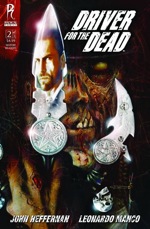 Driver for the Dead #2
Driver for the Dead #2
Written by John Heffernan
Art by Leonard Manco
(Radical Comics)
Pull: YES, but be aware of gore and violence.
Annie says: It has been a while since I’ve gotten to review something that I feel is as well done as it is original, but this comic seems to be it. Take all of that New Orleans voodoo and magic you hear stories about and slam them into a comic book with absolutely grotesque and graphic illustrations and you have a sure-fire win on your hands.
Alabaster Graves is responsible for transporting dead bodies from their place of death to their final resting place. The play on words with his name has me swooning over this comic already—Alabaster GRAVES, get it? Nothing is as easy as it seems in this issue. A well known doctor in a local community has died and Alabaster is called in to relocate the body. Seems pretty run of the mill until we’re introduced to the antagonist of this story: a crazy, confederate zombie who is running around town stealing other people’s magical powers and using them as his own. Don’t understand? He visits one woman whose magic lives in her hands and cuts her hands off, attaches them to his wrists and now possesses her power. He visits another man whose magic resides in his tongue, rips the man’s tongue out and reattaches it in his own mouth. I’m not doing the plotline justice here but that’s because I really want to encourage you to pick up this issue (and the one prior). The way the dialogue is played out in this comic makes you want to read more about them. You’re given a lot of information about whom everyone is and why each character is important but it’s done in a way where it’s comfortable and easy to absorb.
The artwork really enhances the already-great plot. The story is pretty violent and Leanord Manco does an incredible job of detailing it. The first person to die in this issue is impaled by a zombie army and I’ll be damned if you don’t see every last entrail. The dialogue is pretty straightforward whereas the artwork does a great job of building up the suspense of each situation. I didn’t think it was possible to illustrate someone’s head being ripped off until I read this comic.
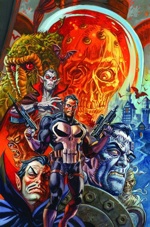 Franken-Castle #21
Franken-Castle #21
Written by Rick Remender
Art by Dan Brereton, Andrea Mutti & Luca Malisan
(Marvel Comics)
Pull: It’s a fun story. Maybe to yes, depending on how much you like monsters and the Punisher.
Chris says: Sometimes you just need to be reminded that the Punisher is a crazy person. In this final issue of Franken-Castle, the Punisher’s compatriots dump him on Monster Island so he can heal his disparate body parts back together after a fight with Wolverine’s son last issue. That is officially the oddest sentence I have ever written.
While healing (he has a supernatural thingy that lets him do that), he hunts monsters fifteen times his size and keeps up an inner monologue to his lonnnnng dead wife about how he’ll make them all pay. The bad people of the world. Not the monsters. Although it’s the monsters that end up getting the pointy end of the Punisher’s monologues. Writer Rick Remender (who is really showcasing some range in today’s Pull List!) pulls a fast one and reveals that the supernatural thingy helping Frank Castle heal is genuinely driving him crazy. A team of movie monsters heads after Frank and manages to get through to him. The Mummy points out that The Punisher is in danger of losing his one redeeming quality, that he only kills those who deserve it.
It’s a fun story, overall, and Dan Brereton’s paints give it the setting a humid look that is very fitting for the jungle the characters are fighting in. A back-up story by Remender, drawn with a bright grit by Andrea Mutti & Luca Malisan, is substantially darker and more the street-level Punisher that people are familiar with. The story ends with one word: “BACK.”
 Terminator: 1984 #1
Terminator: 1984 #1
Written by Zack Whedon
Art by Andy MacDonald
(Dark Horse Comics)
Pull: If you’re a fan of the Terminator franchise (at its best—you need not have been able to stomach the beautiful mess that was Salvation…), then yes. If Cameron’s movies and the too-short-lived television series haven’t already sold you, however, then I can’t say that there’s necessarily anything here that’s going to change your mind.
Matt says: Zack Whedon and Andy MacDonald kick off the sequel to their Terminator: 2029 series this week—and, in classic Terminator style, the sequel takes place 45 years before the first series. Most fun of all, issue #1 takes place in and around James Cameron’s classic first movie; we see a couple of familiar scenes interwoven with Whedon’s brand new plot. Action here largely follows the character Ben—a Whedon/MacDonald creation from the 2029 series, who continues to be a well-written, likeable protagonist—as he attempts to carry out his own mission in the past.
So far, this series looks like a ret-con; the events of the first movie play out as written, but Ben’s story is giving us a larger, hidden context for the movie. (Managing to also answer a nagging question from the first film: how did the police and paramedics get to the scene so quickly…?) What will be interesting to see is whether or not this continues to be a straight-up ret-con. The Terminator movie franchise has fallen into a terrible habit over the last ten years of simply elaborately setting up the first movie; Connor’s “No fate but what we make” mantra starts to sound incredibly hollow when each new addition to the franchise simply drives home the idea that, no matter what the protagonists do, the future is going to turn out the same. By carrying us beyond the first movie in the plot of issue 1, however, Whedon allows himself a little more “wiggle room”; the future could yet be rewritten, and I’m keen to see where this is all going.
Whedon’s scripting is as capable here as it was in 2029; large parts of the story are told without dialogue or captions, and it’s to Whedon’s credit that the use he makes of each add something to the pages that the pictures aren’t already doing. This of course is still to leave much of the success or failure of each page on MacDonald’s shoulders, and—assisted nicely by Dan Jackson on color duties—he pulls it off well. Nothing about this book is going to take your breath away just yet—but everything here is solid, and it’s enjoyable to read.
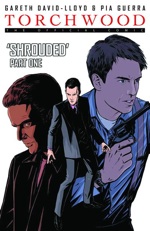 Torchwood #3
Torchwood #3
Written by Gareth David-Lloyd
Art by Pia Guerra
(Titan)
Pull: For Torchwood fans, yes, but skip otherwise. Wait for the title to mature a little.
Chris says: I still hate you, Torchwood, but I love Ianto. So a Torchwood written by Gareth David-Lloyd, the actor who portrayed Ianto, and illustrated by Y: The Last Man’s Pia Guerra? Sold.
Ianto is out picking up coffee (flirtatiously, of course) when Rhys and John Hart ring him up and ask him out for a beer. This being Torchwood, things get complicated from there. This Rhys and John are from after the events of Children of Earth, and they’ve got a warning for Ianto…
Unfortunately, the story ends shortly after Rhys and He-Who-Is-Not-Spike-But-Really-Is give Ianto the scoop on what’s coming for him, which is quite a tease. The rest of the issue is devoted to two separate stories, one the continuation of the Billis Manger arc from Torchwood #1 (the quality of which has taken a dive since the premiere issue) and another a snippet of prose from Torchwood and Doctor Who writer James Moran. I understand that this comic series has a lot of content they want to get out, but this is the second time in three issues that the shortened stories have negatively impacted the title. The first issue could have used more space to tell its primary story, while this one uses its truncated space so well that you wish you had the next part of the story now, and not the other two tales in the issue.
Still, I am essentially complaining about something being too good here, which bodes well for this series. It’s legs are a little wobbly beneath it, but Torchwood the comic is continuing to showcase stories more interesting than the show itself has managed.
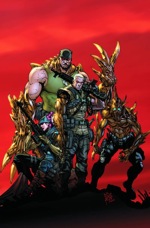 Wetworks: Mutations
Wetworks: Mutations
Written by Kevin Grevioux and Christopher Long
Art by Julius Lopez
(DC Comics / Wildstorm)
Pull: Dear god, no. With the sad news this past week that the Wildstorm imprint is being retired over at DC, a good many books and characters will be missed. But Mutations is simply the latest in a long line of reasons why Wetworks won’t be one of them.
Matt says: I’ve been following the Wetworks platoon for a long time—since the Portacio/Choi days, in fact, and through every disappointing relaunch since then. Mutations, however, is fairly incomprehensible, even for long-time fans, and even by Wetworks’ more recent standards. The storytelling is muddy, the scripting bland, and the characters indistinguishable. But then, if you are familiar with writer Kevin Grevioux, none of this is going to surprise you very much. What Grevioux’s Underworld movie series had going for it, of course, is that—even at its worst—it was fun to look at. Every slick Hollywood cliché was employed to make all three movies look like two-hour-long music videos. Alas, the much-hyped “super-detailed” art of Julius Gopez in Mutations is not slick, and what little visual interest it carries comes at the expense of the storytelling. Backgrounds are largely nonexistent, it’s hard to tell what’s going on in the panels most of the time, and somehow 28 overwritten pages still fail to tell much of a story.
The story finds a largely-unspecified group of villains attempting to cross daemonites with vampires. The villains practically put their tasks aside to take time to spout expository information about themselves, but we still don’t really get much of a sense of any of them. The heroes, meanwhile—the Wetworks squad and two vampires—spend most of the issue complaining about their problems while fighting their way through impossible odds. Each step of the way, they manage to beat the odds with the help of various di ex machinae: either the narrative-carrying protagonist blacks out and wakes up when the threat has somehow been defeated; or the “on the fritz” symbiotes happen to kick into super-high gear when the odds get too great. Either way, the narrative manages to never surprise the reader, even when the same plot device can surprise the same character as many as three separate times: watch Dane’s reaction when he realizes that the symbiote is growing him a new arm. And then watch him get surprised by it again on the next page. And then again the page after that…
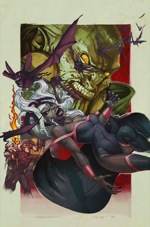 X-Men vs. Vampires #1
X-Men vs. Vampires #1
Written by James Asmus, Christopher Sequeira, Peter David, Rob Williams, Chris Claremont
Art by Tom Raney, Sana Takeda, Mick Bertilorenzi, art by Doug Braithwaite, Bill Sienkiewicz
(Marvel Comics)
Pull: If you like vampires, and you like the X-Men, this book’s a nice little taste of both. If you’re not a fan of one or the other to begin with, however, this book’s going to have too much of the stuff you don’t like to really be able to enjoy the stuff you do.
Matt says: Like any collection of short stories, the first issue of X-Men vs. Vampires is uneven. The first tale, “From Husk ‘til Dawn,” is the weakest link here; Asmus overwrites the story, and Tom Raney’s art is capable without ever impressing. Fortunately, the book gets progressively better from front to back. Sequeira and Takeda give us a Dazzler story that manages to be a nice twist on the usual tropes, and best of all, the story is a fun mash-up of genres: the superhero and vampire genres are overlaid with a ’70s “blaxploitation” funk that manages to perk up an otherwise overwritten ending. Third on deck is Peter David’s “Rue Blood” (with art handled by Mick Bertilorenzi); it’s a fun read, even though it’s essentially a recycling of two over-used tropes. First, we have Rogue (sort of—you’ll see what I mean if you read it) taking her turn as Buffy the Vampire Slayer; and then we have the standard “Vampire in love with a human who seems to be the reincarnation of his long-dead soulmate,” given a little bit of freshening up through the translation of the trope into the Hindu language of reincarnation and the Gita. A few extra fun-and-creepy characters and some attractive art manage to keep the story moving, even when we get the feeling that we’ve seen it all before.
Finally, Rob Williams and Doug Braithwaite give us an attractive, albeit simple tale of Magneto encountering a long-lost friend. Both “survived” the Nazis and concentration camps, only to have, each in their own way, become monsters: Leo has done so fairly literally, having been turned into a vampire on his way to a camp, while Magneto has of course spent a good chunk of his career serving as a supervillain. Magneto’s currently taking a(nother) turn as a good guy, however, and so Leo’s tu quoque falls on deaf ears; as a longer piece, this could have been an interesting mediation on atonement and the cycle of abuse. As a shorter piece, it’s simply a character-driven vignette.
The issue wraps with a reprint of the first half of an old Claremont/Sienkiewicz story, “Night Screams!” The Storm-versus-Dracula story is fairly standard, of course; but what’s a lot of fun here is to relive both Claremont in his heyday and Sienkiewicz in his early days. Sienkiewicz was always a strong storyteller—and in “Night Screams!” you can see him already hinting at some of the innovations that will set him apart by the mid-80s. Claremont, meanwhile, gives us his standard overwriting: this last 11 pages will take you as long to read as the first four stories combined! And yet, it’s also a reminder of why we loved Claremont’s writing so much: back before the days of “decompressed storytelling,” Claremont managed to pack pages full of plot, characterization, and style.
Overall, X-Men vs. Vampires is a fun read. It’s non-essential, it isn’t likely to show up in future canon, and nothing in here is really going to speak much to The Human Condition. But in a world increasingly filled with vampires, issue #1 still manages to avoid wearing out its welcome; I’ll probably stick around for issue #2.
Chris Greenland didn’t have a lot of hope for this week’s batch but damn Marvel really nailed it.
Annie Gala is trying her hand at stoicism.
When Matt Lampert isn’t writing about comics, he’s a philosophy professor in New York City.










